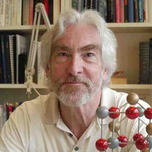Victor E. Henrich
Eugene Higgins Professor of Applied Physics and Professor of Physics
 Vic Henrich, B.S.E. and Ph.D. University of Michigan, faculty member at Yale since 1978: While your research has focused on surfaces, your scientific contributions and service to Yale extend to great depths. It is at surfaces where solid materials interact with their surroundings. Tools to study the properties of surfaces emerged in the 1960s and, to this day, largely have been used to study metals and semiconductors. You devoted your research to understanding the surfaces of metal oxides. Oxides present an array of challenges yet hold keys to fields such as heterogeneous catalysis, geology and the environment, semiconductor technology, and exotic phenomena such as high temperature superconductivity.
Vic Henrich, B.S.E. and Ph.D. University of Michigan, faculty member at Yale since 1978: While your research has focused on surfaces, your scientific contributions and service to Yale extend to great depths. It is at surfaces where solid materials interact with their surroundings. Tools to study the properties of surfaces emerged in the 1960s and, to this day, largely have been used to study metals and semiconductors. You devoted your research to understanding the surfaces of metal oxides. Oxides present an array of challenges yet hold keys to fields such as heterogeneous catalysis, geology and the environment, semiconductor technology, and exotic phenomena such as high temperature superconductivity.
Your seminal work made lasting contributions in a number of these fields. Your leadership on oxide surfaces is exemplified by your book, The Surface Science of Metal Oxides, first published in 1994; despite the fast pace of the field, it remains the definitive text and is the place to start when considering oxide surfaces. Your stature in the field played a key role in nucleating a focused effort on oxide surfaces and interfaces, which ultimately led to a highly successful NSF-funded Materials Research Science and Engineering Center at Yale on this topic, within which you took a leadership role.
You have been an invaluable resource and mentor to students who have gone on to excel in academia as well as in industry. Students appreciated your inspiration and even keel in the face of challenging experiments, where delays are common and progress occurs in spurts. As a testament to your leadership, many students you worked with remain close to you to this day. For the faculty, you could always be counted on not only for your technical insight and clear-eyed judgment but also for your creative solutions to challenges.
Additionally, you were a memorable classroom teacher at both the undergraduate and graduate levels. The course you developed, “The Technological World,” is a model for conveying the concepts behind the ubiquitous electrical and optical technologies that have transformed the lives of humankind. Your impeccable teaching of the flagship first-year graduate course, “Solid State Physics,” launched generations of Yale students into their advanced studies and laboratory research. Your calm, serious, and supportive pedagogical style made your office hours a can’t-miss part of any course you taught.
Your leadership was characterized by wisdom, civility, and generosity. Soon after coming to Yale, you assumed the Chairmanship of Applied Physics and steered it to the beginning of its status as an independent department. You were Director of the Division of Physical Sciences. You served on committees to recognize and recommend candidates for the highest levels of the administration (President, Dean of the College, and Dean of the Graduate School). You emerged from all of these high-stress assignments virtually unscathed.
Finally, alongside your wife Master Jan Henrich, you served as Associate Master of Trumbull College with enthusiasm and compassion for sixteen years, influencing a generation of undergraduates. Yale students always felt that you considered your college duties as equal in importance to your other academic commitments.
For a career of outstanding research, steady leadership, and generous service, we salute you as you head into retirement.
Tribute Editor: Penelope Laurans